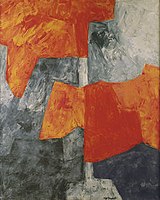Our website is made possible by displaying online advertisements to our visitors.
Please consider supporting us by disabling your ad blocker.
Tachisme

Tachisme (alternative spelling: Tachism, derived from the French word tache, stain; French pronunciation: [taʃism] ⓘ) is a French style of abstract painting popular in the 1940s and 1950s. The term is said to have been first used with regards to the movement in 1951.[1] It is often considered to be the European response and equivalent to abstract expressionism,[2] although there are stylistic differences (American abstract expressionism tended to be more "aggressively raw" than tachisme).[1] It was part of a larger postwar movement known as Art Informel (or Informel),[2] which abandoned geometric abstraction in favour of a more intuitive form of expression, similar to action painting. Another name for Tachism is Abstraction lyrique (related to American Lyrical Abstraction). COBRA is also related to Tachisme, as is Japan's Gutai group.
After World War II the term School of Paris often referred to Tachisme, the European equivalent of American abstract expressionism. Important proponents were Jean-Paul Riopelle, Wols, Jean Dubuffet, Pierre Soulages, Nicolas de Staël, Hans Hartung, Gérard Schneider, Serge Poliakoff, Georges Mathieu and Jean Messagier, among several others. (See list of artists below.)
According to Chilvers, the term tachisme "was first used in this sense in about 1951 (the French critics Charles Estienne and Pierre Guéguen have each been credited with coining it) and it was given wide currency by [French critic and painter] Michel Tapié in his book Un Art autre (1952)."
Tachisme was a reaction to Cubism and is characterized by spontaneous brushwork, drips and blobs of paint straight from the tube, and sometimes scribbling reminiscent of calligraphy.
Tachisme is closely related to Informalism or Art Informel, which, in its 1950s French art-critical context, referred not so much to a sense of "informal art" as "a lack or absence of form itself"–non-formal or un-form-ulated–and not a simple reduction of formality or formalness. Art Informel was more about the absence of premeditated structure, conception or approach (sans cérémonie) than a mere casual, loosened or relaxed art procedure.[3]
- ^ a b Ian Chilvers (2004) The Oxford Dictionary of Art, Oxford University Press ISBN 978-0-19172-762-7
- ^ a b Walker, John (1992). A Glossary of Art, Architecture and Design Since 1945 (3rd ed.). G. K. Hall & Co. ISBN 9780853656395.
- ^ Troy Dean Harris, A Note on Art Informel. 2009, Bauddhamata 11.6.09.
Previous Page Next Page


